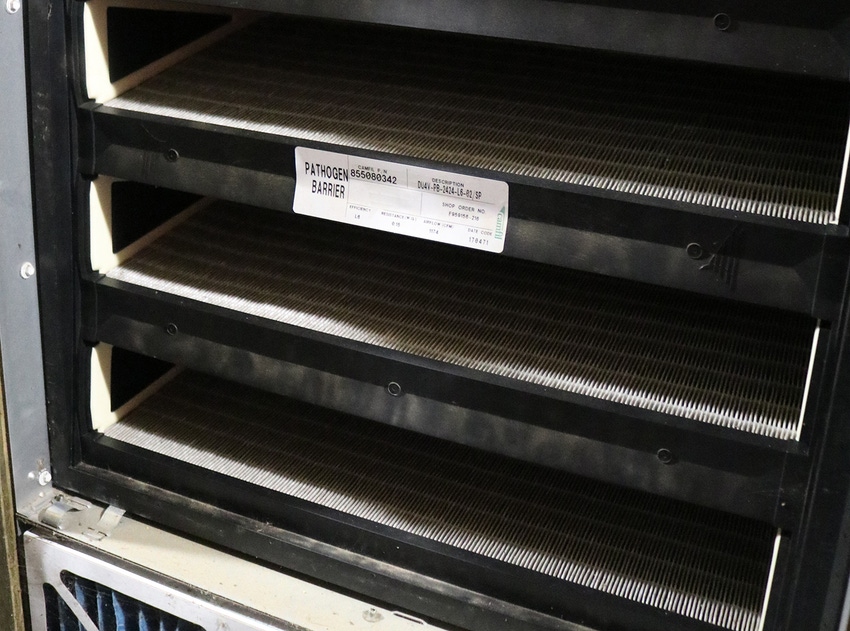To filter or not to filter, that’s not the question anymore
Now the filtration question lies in knowing which factors to consider when making the best of air filtration in your hog barns.
November 13, 2018

By Montse Torremorell, University of Minnesota College of Veterinary Medicine Veterinary Population Medicine Department associate professor, and Kevin Janni, University of Minnesota College of Food, Agricultural and Natural Resources Sciences Department of Bioproducts and Biosystems Engineering professor
Long gone are the days when we debated whether it’s beneficial to install air filtration in a farm. If you are in a high-dense area and you have new breaks often enough that filtration pays off, then filtrate. Whether it is the removal of virus from the air (which is what filters do), or the enhancement and enforcement of basic biosecurity measures which are part of the “filtration package,” air filtration has been shown to reduce the number of porcine reproductive and respiratory syndrome virus breaks.
However, filtration has not always met farm owner expectations. And retrospective data analysis from the Morrison Swine Health Monitoring Project suggests that PRRSV incidence hasn’t been reduced as much as we had hoped for, although it’s still better than no filtration. So, what can be going on?
To help producers and veterinarians to contrast and compare filtration options and to help understand the components that affect filtration, we created a model at the University of Minnesota that estimates the theoretical number of airborne viruses that would enter a barn through either filters or through leakage given certain assumptions. The model takes into account various inputs considered important to affect filtration and provides a look at the interaction between ventilation rate, building leakage, filter particle removal efficiency and particle size distribution where viruses may attach.
We have learned a few things already. First, and the obvious one, is that filtering ventilation air does decrease virus concentration inside filtered barns. Second, ambient virus concentrations and their size distributions, which are largely unknown, have a large impact on virus concentration inside the barn. Although we have done some measurements of virus distribution based on particle size, the relative distribution is likely affected by various factors such as environmental conditions, type of virus, source of virus aerosol, etc.
In general, we can say that if viruses are found mostly in the smallest particles (<1 microns), Minimum Efficiency Reporting Value 14 filters will do quite poorly since their lowest removal efficiency is for particles less than 1 micron (~ 76% removal efficiency). In contrast, if the largest amount of virus is found in medium and large particles (>1 micron), as our studies suggest, then MERV 14 filters should do quite well and the more viruses there are in the largest particles (>3 microns), the better MERV 14 filters do and in this case performance is similar to MERV 16 filters. However, since virus particle size distribution is likely to change throughout the day and season, the only way to minimize the impact of virus particle size distribution is by using higher MERV-rating filters with removal efficiencies above 95%, if not more. But, the overall importance of filter collection efficiencies is uncertain because the ambient virus concentrations and their size distributions are not really known.
The other point that is important to recognize is that there are higher barn virus concentrations with lower mechanical ventilating rates and higher barn leakage rates. In other words, during low ventilation rates (i.e. winter) the number of virus particles per cubic feet per minute is higher than during high ventilation rates (i.e. summer). However, when we consider total amount of virus particles that may enter the barn per minute, then higher ventilation rates result in higher in-barn virus concentration compared to lower ventilation rates. This observation is important also when considering positive-ventilated barns since it is not uncommon that in the winter, they operate at higher flow rates than negative-ventilated barns resulting in the potential introduction of more viruses through the filter, even though leakage is nearly eliminated. Lastly, as it is well known reducing barn static pressure drop by increasing filter area helps reduce leakage and virus concentrations in the barn.
So, it is not a question whether air filtration helps, but rather knowing which factors to consider when making the best of air filtration. Our model does not measure risk of PRRSV infection into a farm, but it shows a fairly complex, not always obvious, interaction between ventilation rate, building leakage, filter particle removal efficiency and viral particle size distribution that knowing it, may be useful to producers and veterinarians when evaluating air filtration systems for sow farms.
For more information about the model, contact Kevin Janni or Montse Torremorell at the University of Minnesota.
You May Also Like



